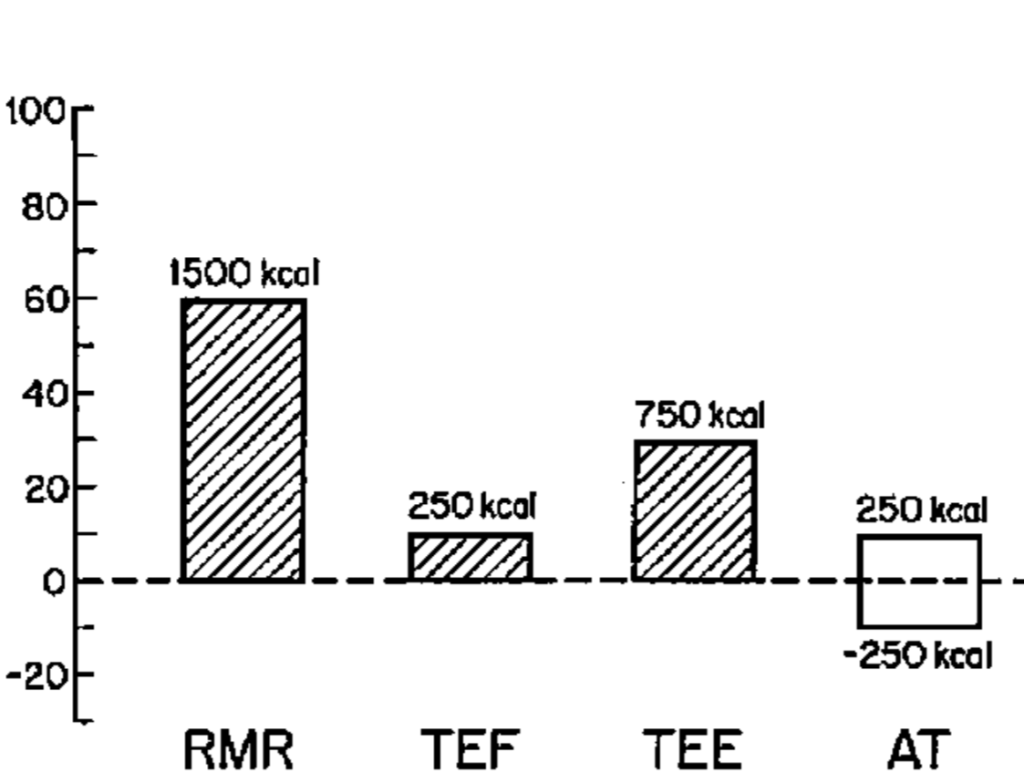The energy utilised by the body is liberated from a number of separate compartments and can be measured as heat. In reality, body heat is measured as one unit, but for theoretical purposes it is convenient to compartmentalise this heat in order to better understand its relevance to weight gain and weight loss. The largest compartment of heat production in the resting metabolic rate (RMR). This is a measure of the amount of energy expended by an individual when lying or sitting at rest with no skeletal muscle movement. The RMR comprises of the energy produced by the normal homeostatic physiological systems plus a small contribution from sympathetic nervous system activity. Related to the RMR is the basal metabolic rate (BMR) which is a similar measurement taken upon waking and at least 12 hours following the last meal. The BMR is usually slightly lower than the RMR. In a 70 kg male the RMR amounts to around 1500 kcal per day of a total 2500 kcal per day, or ~70 % of total energy expenditure (figure 1).

Figure 1. Diagrammatic representation of the contributions to total energy expenditure. TEF = thermic effect of food, RMR = resting metabolic rate, TEE = thermic effect of exercise, AT = adaptive thermogenesis. Total energy expenditure for a 70 kg male = 2500 kcal.
The RMR is therefore quantitatively the largest compartment of energy utilisation in humans and this contribution is largely dependent on the degree of skeletal muscle (fat free mass) present. Obese individuals that have not ‘dieted’ and athletes have higher RMRs than sedentary individuals of normal stature due to their increase levels of skeletal muscle mass. The energy balance equation that can be found in most medical and nutritional textbooks takes the energy content of the food and subtracts the RMR and the amount of energy utilised during activity to estimate the net weight gain or loss of an individual. However, this simplified equation does not take into account the other energy compartments of the body. Unless these other compartments are considered the energy balance equation is a useless measure that is of no interest other than to illustrate the outdated nature of most textbooks. So what are the other energy compartments and how do they relate to weight gain and loss?
The second largest compartment of energy expenditure in humans in the thermic effect of exercise (TEE), also called the thermic effect of activity (TEA). In our hypothetical man the TEE accounts for around 750 kcal of the total 2500 kcal expenditure or around 30 % (figure 1). The primary determinant of the TEE is the amount of work performed. Nutritional and dietary factors that can affect the RMR have little effect on the TEE and once bodyweight is accounted for, both obese and lean subject have similar responses to exercise in terms of the TEE. The TEE should not be confused with the energy expended by the exercise itself, as the TEE refers specifically to the post exercise thermogenesis caused by the physical activity. This rise in the utilisation of energy following physical activity can last for many hours and its a response to the activation of the sympathetic nervous system and the mobilisation of energy to perform the work of restoration of homeostasis.
The thermic effect of food (TEF) refers to the utilisation of energy in response to the ingestion of food. This is also sometimes called dietary induced thermogenesis. This compartment can be accounted for largely by the energy required to absorb, digest, transport and store nutrients. However, the ingestion of food does cause a stimulation of the sympathetic nervous system and this can account for some of the postprandial thermogenesis. Generally the larger the ingestion of calories the larger the TEF. However, the micronutrient ratios can have a significant effect on the TEF. Ingestion of protein causes the largest postprandial thermogenic response, followed by carbohydrates and then fat. Evidence suggests that obese individuals have a blunted TEF, although the exact cause and effect of this relationship are not fully understood. The TEF accounts for approximately 10 % of total daily energy expenditure (figure 1), but this can rise significantly in those with high calorie intakes, such as in athletes.
The last compartment of energy is called adaptive thermogenesis. In animals adaptive thermogenesis is well studied, but less research has been performed on humans. Generally adaptive thermogenesis is accounted for by changes to the RMR is response to environmental change such as ambient temperature, food intake, emotional stress, injury or other factors. Rodents rapidly adapt to a cold environment through the utilisation of stored energy to produce heat, additional to any heat generated from shivering. Such non-shivering thermogenesis is known to be important in human infants, but it is thought that its contribution to total energy expenditure may decline with age. Non-shivering thermogenesis is caused by activation in the sympathetic nervous system and the release of thyroid hormones. Overnutrition also results in adaptive thermogenesis and in response to increases in the intake of calories RMR can increase by 15 %. Adaptive thermogenesis accounts for around 15 % of daily energy expenditure.
Dr Robert Barrington’s Nutritional Comments: Clearly there are more avenues for the expenditure of energy than the RMR or the amount of energy utilised during exercise. Ignoring the TEF, the TEE and adaptive thermogenesis is not helpful because these compartments contribute significantly to the total energy expenditure of human. Under conditions of high quality nutrition the hypothalamus can waste energy in a number of ways and this prevents overeating causing weight gain. When insulin resistance develops from a poor quality diet, the hypothalamus becomes insensitive to the signal hormone leptin which normally relays information about the degree of body fat present. Under such circumstances the RMR, the TEF, the TEE and adaptive thermogenesis can all be down regulated in order to preserve energy, which results in weight gain through the slow accumulation of body fat.
RdB
